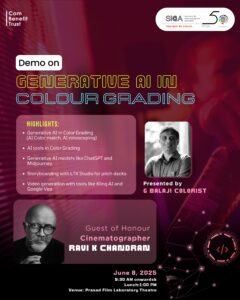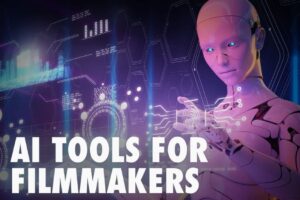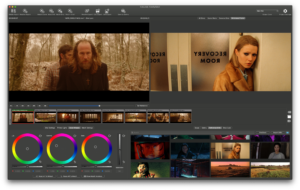
AI artificial Intelligence : Cinema!
Jun 06 2025
SICA on creating awareness about possibilities of understanding AI gears up for a workshop to be conducted for its members as educative initiative on behalf of CAM BENEFIT TRUST on 8th June Sunday at Prasad lab chennai 9.30 am onwards.

A Basic Understanding of AI for Cinematographers: Types, Visual Aspects, and Tools

Artificial Intelligence (AI) is transforming the world of cinema, offering cinematographers innovative tools to enhance creativity, streamline workflows, and push the boundaries of storytelling. For filmmakers, understanding AI’s capabilities—its types, visual applications, and relevant software—can open new creative possibilities. This article provides a simple introduction to AI for cinematographers, focusing on its role in visual storytelling, including text-to-image, text-to-video, and image-to-video generation.

What is AI in Cinema?
AI refers to computer systems that mimic human intelligence to perform tasks like analyzing data, generating content, or making decisions. In cinema, AI assists with tasks such as scriptwriting, editing, visual effects, and generating entirely new visuals. For cinematographers, AI can enhance pre-production, production, and post-production processes, saving time and unlocking creative potential.
Types of AI Relevant to Cinema
AI comes in various forms, each serving specific purposes in filmmaking. Here are the main types cinematographers should know:
1. Generative AI- Creates new content, such as images, videos, or music, based on text prompts or existing visuals. Examples include text-to-image tools like Midjourney or text-to-video platforms like Runway.
2. Computer Vision AI: Analyzes and interprets visual data, such as recognizing objects or tracking motion in footage. This is useful for automated editing or visual effects.
3. Machine Learning (ML): Enables systems to learn from data and improve over time. ML powers tools like color grading or scene analysis in editing software.
4. Natural Language Processing (NLP): Processes and generates human-like text. NLP is used in script analysis tools or generating subtitles automatically.
These types of AI work together to create tools that simplify and enhance cinematography workflows.

Visual Aspects of AI in Cinema
AI is revolutionizing how cinematographers approach visuals, from pre-visualization to final output. Here’s how it impacts key visual aspects:
– Pre-Visualization: AI tools can generate storyboards or concept art from text descriptions, helping cinematographers visualize scenes before shooting. For example, a prompt like “a futuristic city at dusk with neon lights” can produce detailed images to guide set design or lighting plans.
– Cinematography Assistance: AI-powered cameras and software can suggest optimal framing, lighting, or lens choices based on scene analysis. Tools like Adobe Premiere Pro’s AI features can analyze footage for better shot selection.
– Visual Effects (VFX): AI simplifies complex VFX tasks like rotoscoping, background removal, or adding realistic CGI elements. For instance, AI can seamlessly integrate CGI characters into live-action footage.
– Color Grading and Editing: AI automates color correction, matching shots across scenes, or enhancing low-light footage, saving hours in post-production.
– Real-Time Rendering: AI-driven rendering engines, like those in Unreal Engine, allow cinematographers to see high-quality visuals in real-time, aiding virtual production setups.

AI Software and Tools for Cinematographers
Here’s a look at key AI-powered tools and their applications in cinema:
1. Text-to-Image Tools:
– Midjourney: Generates high-quality concept art or storyboards from text prompts. Cinematographers can use it to visualize scenes or inspire set designs.
– DALL·E 3 Creates detailed images from text, ideal for pre-visualization or creating unique textures for VFX.
– Stable Diffusion: An open-source tool for generating images, customizable for specific cinematic styles.
Use Case: Enter a prompt like “a moody forest with fog and golden light” to generate reference images for lighting setups or location scouting.
2. Text-to-Video Tools:
– Runway Converts text prompts into short video clips, useful for creating rough animations or motion storyboards.
– Sora (by OpenAI): Generates short, high-quality videos from text, ideal for prototyping scenes or creating abstract visuals.
– Pika.art: Offers simple text-to-video generation for quick creative experiments.
Use Case: A cinematographer can input “a spaceship間に Vicinity of a dark cave with glowing crystals” to generate a short video for a sci-fi film’s concept reel.
3. Image-to-Video Tools:
– Runway Gen-2: Transforms still images into animated sequences by adding motion or effects.
– Kaiber: Converts static images into dynamic videos, useful for creating animated backgrounds or transitions.
– Adobe After Effects (with AI plugins): Enhances image-to-video workflows with AI-driven motion tracking and effects.
Use Case: Turn a single concept art image of a spaceship into a short animated fly-through for a pitch video.
4. Editing and VFX Software:
– Adobe Premiere Pro and After Effects: Use AI features like auto-reframe, scene detection, and background removal to speed up editing.
– DaVinci Resolve: Employs AI for color grading, audio enhancement, and facial recognition for quick edits.
– Unreal Engine: Uses AI for real-time rendering in virtual production, allowing cinematographers to shoot in virtual environments.
Use Case: Automatically color-match shots across a scene or remove a green screen background without manual keying.
How Cinematographers Can Start Using AI
1. Experiment with Free Tools: Try open-source tools like Stable Diffusion or free tiers of Runway to explore text-to-image and text-to-video generation.
2. Integrate with Existing Workflows: Use AI plugins in familiar software like Adobe Creative Cloud or DaVinci Resolve to enhance existing processes.
3. Learn Prompt Engineering: Craft precise text prompts (e.g., “a cinematic wide shot of a desert at sunrise, 4K, golden hour lighting”) to get better results from generative AI tools.
4. Stay Updated Follow platforms like X or industry blogs to discover new AI tools and updates, as the field evolves rapidly.
5. Collaborate with Teams: Work with VFX artists or editors to combine AI-generated assets with traditional techniques for seamless results.
Benefits and Considerations
Benefits:
– Time-Saving: AI automates repetitive tasks like rotoscoping or color correction.
– Creative Freedom Generate unique visuals or test ideas quickly without extensive resources.
– Accessibility: Many AI tools are user-friendly and don’t require advanced technical skills.
Considerations:
– Learning Curve Some tools require practice to master prompt crafting or integration.
– Ethical Concerns: Be mindful of copyright issues when using AI-generated content based on existing works.
– Quality Control: AI outputs may need refinement to match a film’s specific aesthetic.
Conclusion
AI is a game-changer for cinematographers, offering tools to create stunning visuals, streamline workflows, and explore new creative ideas. By understanding AI types like generative AI and computer vision, and experimenting with tools like Midjourney, Runway, or DaVinci Resolve, cinematographers can enhance their craft. Start small, integrate AI into your existing workflow, and stay curious about new developments to unlock its full potential in cinema.
Drafted by
CJ Rajkumar
